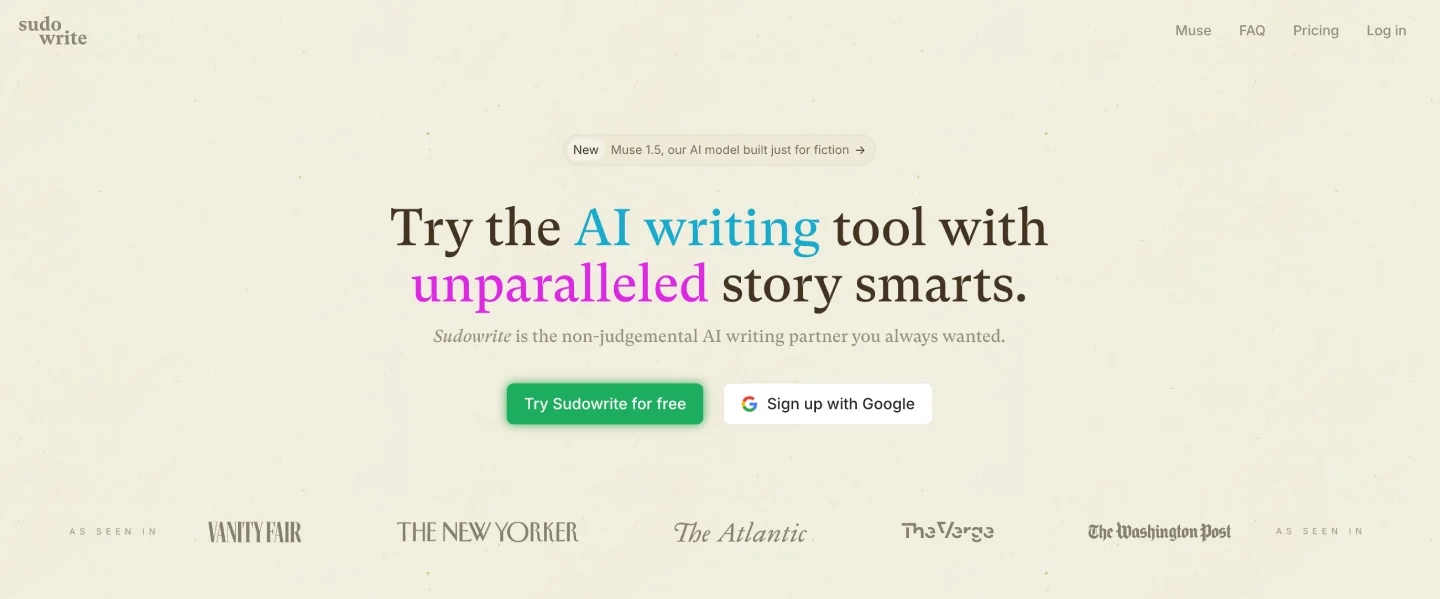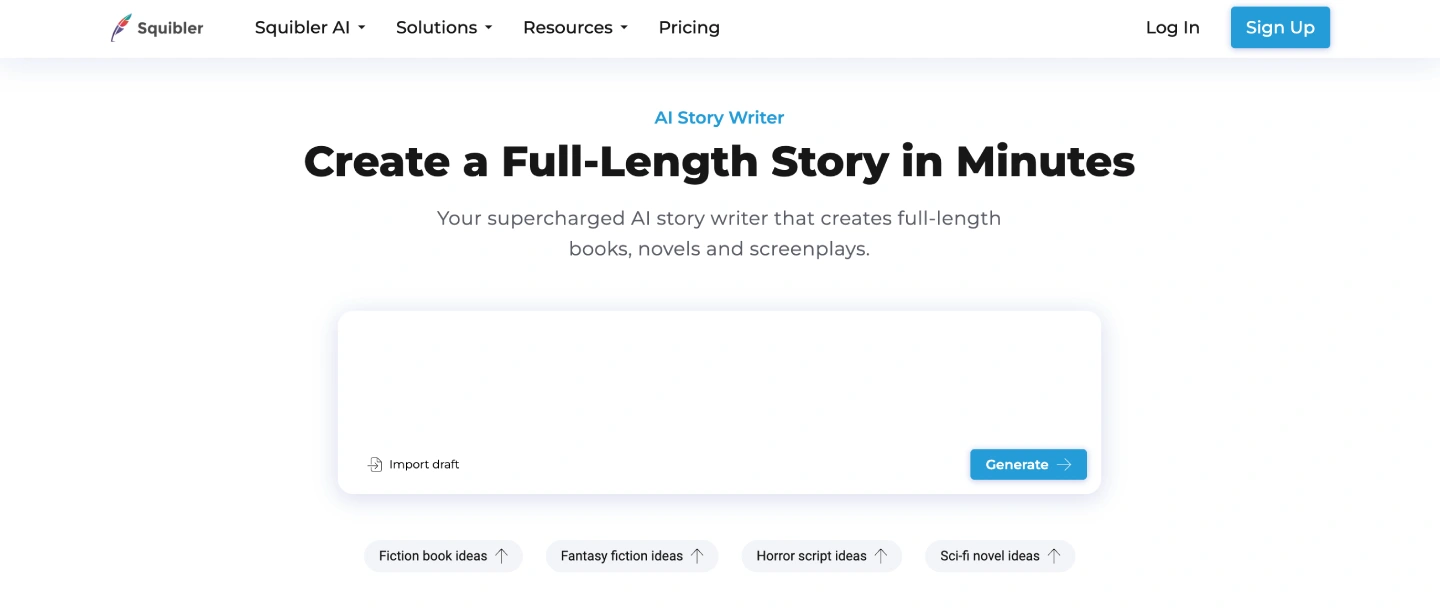Staring at a blank page for hours, furstrated with how to write a book? You're not alone. Most aspiring authors abandon their book dreams after struggling with writer's block, plot holes, or simply running out of steam halfway through chapter three. But what if there was a writing partner who never gets tired, never runs out of ideas, and can help you push through those creative roadblocks? That's exactly what AI writing tools offer modern authors. Learning how to write a book with artificial intelligence isn't about replacing your creativity—it's about amplifying it.
Today's AI writing assistants can help brainstorm plot twists, develop complex characters, write compelling dialogue, and even generate entire chapters based on your vision. Whether you're crafting your first novel or your tenth non-fiction guide, these tools can dramatically reduce the time between "I have an idea" and "I have a finished manuscript."
The best part? You don't need to be tech-savvy or spend thousands of dollars. With the right approach and tools, you can leverage AI to overcome the biggest challenges that stop most people from ever finishing their books.
Understanding the AI Book Generator Revolution
The emergence of ai book writer technology has democratized the publishing industry, making professional-quality writing accessible to anyone with a story to tell. These advanced platforms utilize natural language processing and machine learning algorithms to understand context, maintain narrative consistency, and generate human-like prose that aligns with your unique voice and style.
Modern AI writing tools can assist with multiple aspects of book creation, including plot development, character building, dialogue generation, and scene description. They analyze vast databases of literature to provide contextually appropriate suggestions while maintaining originality in every generated piece.
Key benefits of using AI for book writing include:
- Accelerated writing speed - Generate thousands of words in minutes rather than hours
- Consistent quality maintenance - AI ensures narrative flow and style consistency throughout your manuscript
- Creative block elimination - Unlimited idea generation and plot suggestions keep your writing momentum strong
- Multi-genre versatility - Adapt writing style and tone for fiction, non-fiction, romance, mystery, and other genres
The technology continues evolving rapidly, with each new generation offering more sophisticated understanding of narrative structure, character development, and genre conventions. Authors who embrace these tools gain significant advantages in today's competitive publishing landscape.

How to Write a Book with AI: The Complete 7-Step Process
Before exploring specific AI tools, understanding the systematic approach to AI-assisted book writing ensures maximum productivity and quality results. This comprehensive process transforms your initial concept into a publishable manuscript through strategic AI collaboration at each crucial stage.
Step 1: Capture and Organize Your Initial Ideas
The foundation of any successful book begins with effective idea capture and organization. Rather than losing precious inspiration to forgotten thoughts, establish a reliable system for recording every creative spark, regardless of how incomplete or fragmentary it may seem initially.
Voice recording represents the most natural and efficient method for idea capture, allowing you to preserve the authentic flow of your thoughts without the interruption of typing. Modern voice note applications automatically transcribe your spoken ideas into searchable text while maintaining the original audio for reference.
Key strategies for effective idea capture include:
- Immediate recording - Capture ideas the moment they occur, whether during conversations, walks, or quiet reflection
- Context preservation - Include situational details that might influence later development
- Emotional notation - Record the feelings or atmosphere you want to evoke in readers
- Fragment acceptance - Don't worry about completeness; even single words or phrases can trigger major developments
This systematic approach ensures no valuable inspiration is lost while building a comprehensive foundation for your book's development.
Step 2: Create a Comprehensive Book Outline with AI Assistance
Transforming collected ideas into a coherent narrative structure requires strategic outline development. AI writing assistants excel at analyzing your raw material and suggesting proven narrative frameworks that enhance reader engagement and story flow.
Effective AI-assisted outlining involves feeding your collected ideas into sophisticated tools that understand story structure, character development, and genre conventions. These platforms can suggest chapter breakdowns, plot progression, character arcs, and thematic development based on successful literary patterns.
Essential outline components include:
- Three-act structure - Establish clear beginning, middle, and end with appropriate pacing
- Character development arcs - Define protagonist growth and supporting character functions
- Conflict escalation - Plan tension building and resolution points throughout the narrative
- Theme integration - Weave meaningful messages naturally into the story structure
Remember that AI-generated outlines serve as starting points rather than rigid blueprints. Your unique vision and creative instincts should guide modifications and refinements to ensure the final structure authentically represents your intended story.
Step 3: Collaborative First Draft Development
The initial draft writing phase benefits tremendously from AI collaboration, allowing you to maintain creative momentum while overcoming the blank page paralysis that stops many authors. This collaborative approach combines human creativity with AI efficiency to produce substantial manuscript progress quickly.
Effective first draft strategies involve alternating between human-written sections and AI-generated continuations. Begin each writing session by providing context about previous events, character states, and intended direction, then allow AI to generate several paragraphs that you can edit, expand, or use as inspiration for your own writing.
Alternative approaches for first draft creation:
- Voice dictation method - Speak your story aloud and use transcription technology to convert speech to text
- Prompt-based generation - Provide detailed scene descriptions and let AI create initial drafts for refinement
- Collaborative expansion - Write opening sentences and use AI to develop full paragraphs or scenes
- Character dialogue generation - Use AI to create natural conversations between established characters
The key lies in maintaining your authorial voice while leveraging AI capabilities to accelerate the writing process and explore creative possibilities you might not have considered independently.
Step 4: Enhance Descriptions and Sensory Details
Once your basic narrative structure exists, AI tools can significantly enhance the richness and immersiveness of your writing through sophisticated description generation. This enhancement phase transforms functional prose into engaging, vivid storytelling that captivates readers.
AI excels at generating evocative sensory descriptions that bring settings, characters, and objects to life through carefully chosen details. These tools can analyze your basic descriptions and suggest specific visual, auditory, tactile, and emotional elements that create stronger reader connections.
Enhancement techniques include:
- Setting visualization - Transform simple location mentions into immersive environments with specific details
- Character physical descriptions - Develop memorable appearances that reflect personality traits
- Atmospheric creation - Build mood and tension through environmental details and sensory information
- Emotional landscape mapping - Use descriptive language to convey character internal states
This enhancement process should maintain your established tone and style while adding layers of depth that engage multiple reader senses and create lasting impressions.
Step 5: AI-Assisted Editing and Refinement
Professional-quality manuscripts require thorough editing that addresses multiple layers of potential improvement, from basic grammar and spelling through advanced style and consistency issues. AI editing tools provide comprehensive first-pass analysis that identifies areas requiring human attention.
Modern AI editing platforms analyze your complete manuscript for grammar accuracy, style consistency, pacing issues, character voice maintenance, and structural problems. These tools can identify repetitive language patterns, suggest stronger word choices, and highlight potential plot inconsistencies.
Comprehensive editing checklist:
- Grammar and mechanics - Correct spelling, punctuation, and basic language errors
- Style consistency - Maintain uniform tone, voice, and narrative perspective throughout
- Pacing analysis - Identify scenes that move too quickly or slowly for optimal reader engagement
- Character voice verification - Ensure each character maintains distinctive speech patterns and personality
While AI editing provides valuable initial feedback, human judgment remains essential for evaluating creative choices, emotional authenticity, and overall narrative effectiveness.
Step 6: Manuscript Analysis and Market Positioning
Before publication, comprehensive manuscript analysis provides data-driven insights into your book's strengths, potential weaknesses, and market positioning opportunities. AI analysis tools compare your work against successful published books in your genre to identify optimization opportunities.
Advanced analysis platforms evaluate multiple aspects of your manuscript, including pacing distribution, emotional arc development, character complexity, and reader engagement patterns. This analytical feedback helps you make targeted revisions that enhance commercial viability while maintaining artistic integrity.
Key analysis areas include:
- Pacing evaluation - Assess whether tension and relaxation periods align with reader expectations
- Character development tracking - Verify that protagonists undergo meaningful growth throughout the story
- Emotional beat analysis - Ensure appropriate emotional highs and lows maintain reader engagement
- Genre convention alignment - Confirm your book meets reader expectations while offering unique elements
This analytical approach provides objective perspective on your work's commercial potential and helps identify specific areas where targeted revisions could significantly improve market success.
Step 7: Marketing Content Creation and Launch Preparation
The final phase involves creating compelling marketing materials that effectively communicate your book's appeal to potential readers. AI tools excel at generating attention-grabbing book descriptions, social media content, and promotional copy that highlights your story's unique strengths.
Professional marketing content requires understanding your target audience, genre expectations, and competitive landscape. AI can analyze successful books in your category to identify effective promotional language patterns and emotional triggers that drive purchase decisions.
Essential marketing components:
- Book descriptions - Craft compelling blurbs that intrigue readers without revealing too much plot
- Social media content - Generate engaging posts for various platforms with appropriate tone and hashtags
- Advertisement copy - Create targeted promotional text for online advertising campaigns
- Author bio and press materials - Develop professional presentation materials for media opportunities
This comprehensive marketing preparation ensures your completed book reaches its intended audience effectively, maximizing the return on your creative and time investment.
Top 3 AI Tools for Book Writing: Detailed Platform Analysis
Now that you understand the complete process for AI-assisted book writing, let's examine three leading platforms that can support your journey from concept to publication. Each tool offers unique strengths and capabilities designed for different writing approaches and author needs.
1. Sudowrite: Premium AI Writing Partner for Fiction Authors
Sudowrite stands out as the premier ai book generator specifically designed for fiction writers, offering specialized tools that understand the nuances of creative storytelling. This platform has gained recognition from bestselling authors and major publications, including praise from The New York Times and The New Yorker for its sophisticated approach to narrative assistance.
The platform's Story Bible feature provides comprehensive support for novel development, taking authors from initial concept through detailed outline creation and chapter development. This tool generates thousands of words in the author's established style, maintaining character voice consistency and plot coherence throughout the entire manuscript.

Sudowrite Core Writing Features
Sudowrite's flagship capabilities include multiple specialized writing functions that address different aspects of creative writing. The Write function acts as an advanced autocomplete system, analyzing character development, tone, and plot progression to generate contextually appropriate continuations.
- Describe tool - Creates vivid scene descriptions that engage readers without slowing narrative pace
- Expand feature - Develops rushed sections into fully realized scenes with proper pacing
- Rewrite capability - Offers multiple revision options for any sentence or paragraph
- Feedback system - Provides actionable improvement suggestions based on comprehensive manuscript analysis
Advanced Creative Tools
The platform includes sophisticated brainstorming and planning features that help authors develop complex narratives. Canvas provides a visual workspace for exploring plot points, character arcs, and thematic elements, while the Brainstorm tool generates unlimited creative suggestions that adapt based on user preferences.
Sudowrite's pricing structure reflects its premium positioning at $10 monthly after a free trial period, making it accessible for serious fiction writers seeking professional-grade assistance.
2. Squibler: Complete AI Book Generator Platform
Squibler positions itself as the comprehensive write a book with ai solution, capable of generating entire manuscripts, screenplays, and detailed story outlines within minutes. This platform appeals to authors who prefer systematic approaches to book creation, offering structured templates and project management tools alongside powerful AI generation capabilities.
The platform's full-length book generation feature represents its most distinctive capability, allowing authors to input basic concepts and receive complete manuscripts ready for refinement. This approach particularly benefits authors working with tight deadlines or those seeking to explore multiple story concepts rapidly.

Squibler Smart Writer Technology
Squibler's AI Smart Writer goes beyond simple text generation, incorporating contextual understanding to create coherent narratives that maintain consistency across entire manuscripts. The system can generate new scenes, add conflict elements, enhance descriptions, and develop character interactions based on established story elements.
- Elements creation - Develops complex characters, settings, and objects with minimal input
- Template variety - Genre-specific templates for romance, action, children's books, and screenplays
- Visual integration - Transform text descriptions into accompanying images and video sequences
- Collaboration features - Real-time editing and commenting capabilities for team projects
Project Management Integration
The platform includes comprehensive project tracking tools that help authors maintain writing schedules and monitor progress. List View provides chapter-by-chapter overviews, including word count targets, completion status, and collaborative assignments.
Squibler offers both free and premium options, with the Pro plan at $240 annually providing unlimited AI generation, visual creation capabilities, and professional printing services. This pricing structure makes it competitive for authors seeking comprehensive book development support.
3. Simplified: Versatile AI Book Writer for All Genres
Simplified takes a broader approach to ai book writer functionality, integrating book writing capabilities within a comprehensive content creation platform. This versatility makes it particularly valuable for authors who also create marketing materials, social media content, and other promotional materials for their books.
The platform's AI Book Writer utilizes advanced natural language processing to generate engaging narratives across multiple genres and formats. Authors can create novels, reports, business books, and creative pieces with equal effectiveness, making it suitable for both fiction and non-fiction projects.

Simplified Multi-Purpose Writing Capabilities
Simplified's strength lies in its adaptability across different writing contexts and requirements. The platform maintains separate brand voices, allowing authors to manage multiple projects or clients from a single dashboard while ensuring consistent tone and style for each work.
- Genre flexibility - Effective for fiction, non-fiction, business writing, and educational content
- Brand voice management - Maintain consistent writing style across multiple projects
- Collaboration tools - Team-based editing and review capabilities with real-time commenting
- SEO optimization - Built-in keyword integration and search engine optimization features
Integration and Accessibility
The platform's integration with broader content creation tools provides additional value for authors engaged in self-promotion and marketing. Users can create book covers, social media graphics, and promotional materials using the same platform where they write their manuscripts.
Simplified offers a free tier with limited word generation (2,000 words monthly) and premium plans starting around $12 monthly for expanded capabilities. This pricing structure makes it accessible for beginning authors while providing scalable options for professional writers.
FAQs
Q1: Which AI tool is best for fiction writing and overcoming creative blocks?
A1: Sudowrite is tailored for fiction authors, offering features like scene expansion, the Story Engine, and Canvas critiques to enhance creativity and pace.
Q2: What's best for organizing complex story worlds with consistency?
A2: NovelCrafter’s Codex system lets you track characters, settings, and plot threads seamlessly—ideal for high-structure novel writing.
Q3: Can AI tools produce an entire non-fiction book reliably?
A3: Yes—Youbooks AI turns outlines or notes into full manuscripts with support for tone, references, and real-time research. Content is commercially usable and customizable.
Q4: Are there AI tools that help with worldbuilding and long-term consistency?
A4: Claude 3.5 offers strong long-context memory and understanding—helping maintain cohesive characters, plot, voice, and world continuity across long manuscripts.
Q5: Is it legal to submit AI-assisted manuscripts to publishers?
A5: This remains murky. Some agents require confirmation that the work is your own. Many writers use AI for ideas or outlines but heavily edit each draft themselves to ensure originality. Always follow submission guidelines carefully.
Conclusion: Embracing the Future of Book Writing
The integration of artificial intelligence into book writing represents a fundamental shift in how authors approach their craft, offering unprecedented opportunities to accelerate the creative process while maintaining artistic integrity. These three platforms—Sudowrite, Squibler, and Simplified—each provide unique advantages for different types of writers and projects.
Sudowrite excels for fiction authors seeking sophisticated narrative assistance, while Squibler offers comprehensive manuscript generation capabilities for authors preferring systematic approaches. Simplified provides versatile writing support within a broader content creation ecosystem, making it ideal for authors who need marketing and promotional capabilities alongside their writing tools.
The key to successful AI-assisted book writing lies in selecting the right tool for your specific needs and learning to collaborate effectively with artificial intelligence. These platforms don't replace human creativity—they amplify it, providing authors with powerful partners capable of transforming ideas into compelling narratives more efficiently than ever before.
As AI technology continues advancing, authors who embrace these tools gain significant competitive advantages in today's rapidly evolving publishing landscape. The future of book writing belongs to those who successfully blend human creativity with artificial intelligence capabilities, creating works that neither could achieve alone.
 Submit Your AI Tool For FREE!Showcase Your Innovation To Thousands Of AI Enthusiasts!
Submit Your AI Tool For FREE!Showcase Your Innovation To Thousands Of AI Enthusiasts! Submit Your AI Tool For FREE!Showcase Your Innovation To Thousands Of AI Enthusiasts!
Submit Your AI Tool For FREE!Showcase Your Innovation To Thousands Of AI Enthusiasts! Submit Your AI Tool For FREE!Showcase Your Innovation To Thousands Of AI Enthusiasts!
Submit Your AI Tool For FREE!Showcase Your Innovation To Thousands Of AI Enthusiasts! Submit Your AI Tool For FREE!Showcase Your Innovation To Thousands Of AI Enthusiasts!
Submit Your AI Tool For FREE!Showcase Your Innovation To Thousands Of AI Enthusiasts! Submit Your AI Tool For FREE!Showcase Your Innovation To Thousands Of AI Enthusiasts!
Submit Your AI Tool For FREE!Showcase Your Innovation To Thousands Of AI Enthusiasts!







No comments yet. Be the first to comment!